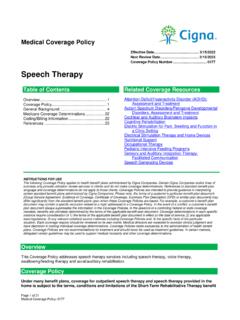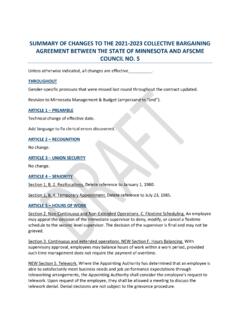Transcription of The Children Act 1989 guidance and regulations
1 The Children Act 1989 guidance and regulations Volume 3: planning transition to adulthood for care leavers Publication date: October 2010 Implementation date: 1 April 2011 Revision date: January 2015 2 Contents Preface 5 Status 5 Changes in the current version 6 Chapter 1: Introduction and summary 7 Context 7 The Children and Young Persons Act 2008 8 Principles for transition 9 Chapter 2: The legal framework 10 Definitions of categories of Children entitled to care leaving support 10 Qualifying Children 15 Special guardianship 16 Access to advocacy 17 Chapter 3: Pathway planning and personal advisers 18 Care planning and pathway plans 18 Relevant Children and pathway plans 19 Personal advisers 23 Qualifications and skills 24 Functions 25 Budget holding 30 Training and supervision 30 Personal adviser to 25 30 Chapter 4.
2 Care leavers aged 18-24 33 Introduction 33 Duties 33 Pathway plan for former relevant Children 34 Reviews of pathway plans 35 3 Access to Records 36 Keeping in touch 41 Chapter 5: Education, training and employment 43 Planning for education, training and careers 43 Care leavers from overseas 45 Post graduate courses 45 Higher Education Bursary 45 Apprenticeships 45 Chapter 6: Care leavers who require additional specialist support 47 (a) Disabled young people making the transition to adult services 47 (b) Unaccompanied asylum seeking Children (UASC) 51 (c) Care leavers in the youth justice system 53 Chapter 7.
3 Planning and arranging suitable accommodation for the transition to independent living 58 Introduction 58 Strategic planning and partnerships 59 Commissioning housing and support services 60 Joint protocols 60 Suitable accommodation 61 Accommodation with former foster carers ( staying put arrangements) 63 Supported lodgings 70 Supported housing and Foyers 70 Independent accommodation 71 Social rented housing 72 Privately rented housing 72 Contingency planning and homelessness 73 Tenure for young people aged 16 and 17 74 Vacation accommodation 75 4 Chapter 8: Finance matters 76 Introduction 76 Preparation for the transition to adulthood 76 (1) General principles for developing financial capability and transparency 77 (2) Maximising income and life chance opportunities for care leavers 82 Chapter 9.
4 Representations and complaints 86 Fourteen day informal resolution stage 86 Resolving complaints 87 Monitoring, complaints and representations 88 Appendix A 89 Knowledge and skills of personal advisers 89 Appendix B 94 Supporting good practice so care leavers can succeed in further and higher education 94 Appendix C 97 Planning suitable accommodation for care leavers 97 Appendix D 98 Good practice promoting care leavers health and wellbeing 98 Appendix E 102 Further information about good practice in providing financial support 102 Appendix F 107 transition to adulthood policies and protocols 107 Care Leavers (England)
5 regulations 2010 109 The Children Act 1989 (Higher Education Bursary) (England) regulations 2009 119 Acknowledgements 122 References and resources to support looked after Children s transition to adulthood 123 5 Preface Status Volume 3 of the Children Act 1989 guidance and regulations provides guidance , primarily addressed to local authorities and their staff in England, about their functions under Part 3 of the Children Act 1989. It is issued as guidance under section 7 of the Local Authority Social Services Act 1970 which requires local authorities in exercising their social services functions, to act under the general guidance of the Secretary of State.
6 This guidance should be complied with by local authorities when exercising these functions, unless local circumstances indicate exceptional reasons that justify a variation. The guidance is addressed to: personal advisers Children s services social workers; frontline managers who have particular responsibilities in relation to care leavers and looked after Children ; lead members in local authorities; directors of Children s services; managers of services for care leavers and looked after Children ; and commissioners of services for care leavers and looked after Children .
7 It will also be relevant to partner agencies and to providers of services for care leavers and looked after Children , including agencies in the private, voluntary and public sectors. These regulations and guidance are designed to ensure care leavers are given the same level of care and support that their peers would expect from a reasonable parent and that they are provided with the opportunities and chances needed to help them move successfully in to adulthood. Research and practice show that those leaving care supported according to the following principles have the best chance of a successful transition to adulthood: quality; giving chances where needed; tailoring to individuals needs.
8 This guidance seeks to have these principles at the centre of decision making for care leavers. 6 Changes in the current version The following amendments, revisions and changes have been made in the current version of this guidance ; Chapter 7: Planning and arranging suitable accommodation for the transition to independent living; Suitable accommodation updated paragraph to include further information on suitable accommodation. 7 Chapter 1: Introduction and summary This guidance is intended primarily for local authorities but will also assist other who provide services to care leavers.
9 The guidance provides information for local authorities so they are able to meet the requirements of the Care Leavers (England) regulations 20101 ( the Care Leavers regulations ). This guidance replaces that issued when the provisions of the Children (Leaving Care) Act 2000 amending the Children Act 1989 ( the 1989 Act ) came into operation in 2001. The guidance largely concerns information about the support provided to young who have ceased to be looked after ( those referred to in the legislation as relevant and former relevant Children ). guidance in relation to young people entitled to support to prepare them to leave care but who remain looked after ( eligible Children ) is included in Volume 2 of the Children Act 1989 guidance Care Planning, Placement and Case Review regulations and statutory guidance ( the Care Planning regulations ).
10 This describes a comprehensive framework of assessment, care planning, intervention and case review that must be followed by local authorities to plan the support they will give to prepare 16 and 17 year olds for the time when they will not be looked after. The main aim of the Care Leavers regulations and of this guidance is to make that care leavers are provided with comprehensive personal support so that they achieve their potential as they make their transition to adulthood. The information in this guidance builds on the evidence base that has been over the last ten years as to what constitutes good professional practice in working with care leavers, to provide them with the stability and support necessary so that this group of vulnerable young people achieve positive outcomes2.















![RESPIRATORY SCORE (RS) }µv }Híì] v - Seattle Children's](/cache/preview/2/1/c/3/3/2/f/b/thumb-21c332fb7a957e8091809349dc2f30b0.jpg)


